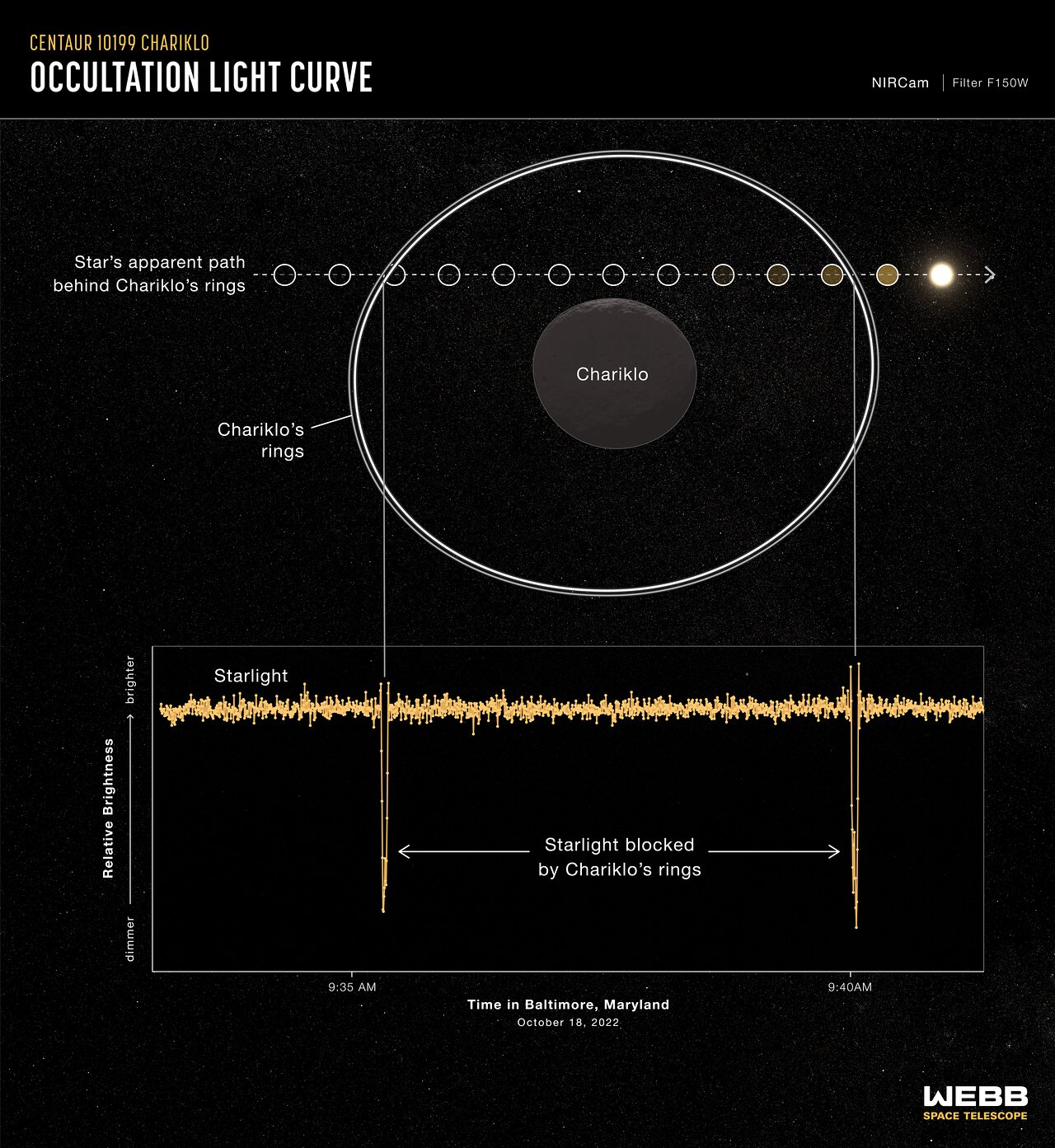Centaur Charliko 10199 Light Curve
In an observational feat of high precision, scientists used a new technique with the NASA/ESA/CSA James Webb Space Telescope to capture the shadows of starlight cast by the thin rings of Chariklo. Chariklo is an icy, small body, but the largest of the known Centaur population, located more than 3.2 billion kilometres away beyond the orbit of Saturn. Chariklo is only 250 kilometers or ~51 times smaller than Earth in diameter, and its rings orbit at a distance of about 400 kilometers from the center of the body.
Pablo Santos-Sanz, from Instituto de Astrofísica de Andalucía in Granada, Spain, has an approved “Target of Opportunity” program (program 1271) to attempt an occultation observation as part of Webb’s solar system Guaranteed Time Observations (GTO) led by Heidi Hammel from the Association of Universities for Research in Astronomy. By remarkable good luck, we discovered that Chariklo was on track for just such an occultation event in October 2022. This was the first stellar occultation attempted with Webb. A lot of hard work went into identifying and refining the predictions for this unusual event.
On 18 October, the team used Webb’s Near-Infrared Camera (NIRCam) instrument to closely monitor the star Gaia DR3 6873519665992128512, and watch for the tell-tale dips in brightness indicating an occultation had taken place. The shadows produced by Chariklo’s rings were clearly detected, demonstrating a new way of using Webb to explore solar system objects. The star shadow due to Chariklo itself tracked just out of Webb’s view. This appulse (the technical name for a close pass with no occultation) was exactly as had been predicted after the last Webb course trajectory maneuver.
The Webb occultation light curve, a graph of an object’s brightness over time (shown above), revealed that the observations were successful. The rings were captured exactly as predicted. The occultation light curves will yield interesting new science for Chariklo’s rings. The rings are likely composed of small particles of water ice mixed with dark material, debris from an icy body that collided with Chariklo in the past. Chariklo is too small and too far away for even Webb to directly image the rings separated from the main body, so occultations are the only tool to characterize the rings by themselves.
The graphic above shows the dimming effects of Chariklo’s rings on a background star.
Top: A diagram showing the change in position of a background star (Gaia DR3 6873519665992128512) relative to the double-ringed centaur Chariklo, during an occultation. An occultation occurs when a background object is temporarily blocked from view by a foreground object. During this occultation event, the star passed behind Chariklo’s rings, but not behind its main body.
Bottom: A graph showing the change in apparent brightness of the star during the occultation event. This type of graph is known as a light curve. The graph shows the sharp dips in apparent brightness of the star over time as the rings of Chariklo (the largest-known Centaur) passed in front of it on October 18, 2022. Each dip on the graph corresponds to the shadows of two rings around Chariklo, which are ~4 miles (6-7 kilometers) and ~2 miles (2-4 kilometers) wide, and separated by a gap of 5.5 miles (9 kilometers). The two individual rings are not fully resolved in each dip of this light curve.
The data show 1.5-micron light captured by Webb’s Near-Infrared Camera (NIRCam) using its F150W filter.
[Image Description: The graphic has two parts. At the top is a diagram showing the change in relative position of a background star with respect to an icy body and its rings. Below the diagram is a graph showing the change in relative brightness of the star over time. The diagram and graph are aligned to show the relationship between the relative position of the background star and the object and rings, and the measurements on the graph.]
Credit:NASA, ESA, CSA, Leah Hustak (STScI), Pablo Santos-Sanz (IAA-CSIC), Nicolás Morales (IAA-CSIC), Bruno Morgado (UFRJ, ON/MCTI, LIneA)
About the Image
| Id: | charliko1 | |
|---|---|---|
| Type: | Chart | |
| Release date: | 27 January 2023, 21:04 | |
| Size: | 15999 x 17409 px | |


